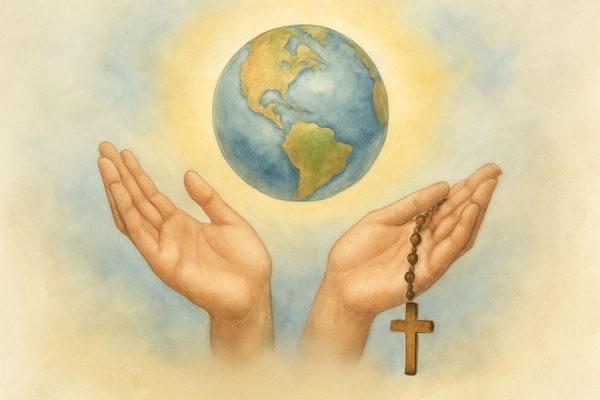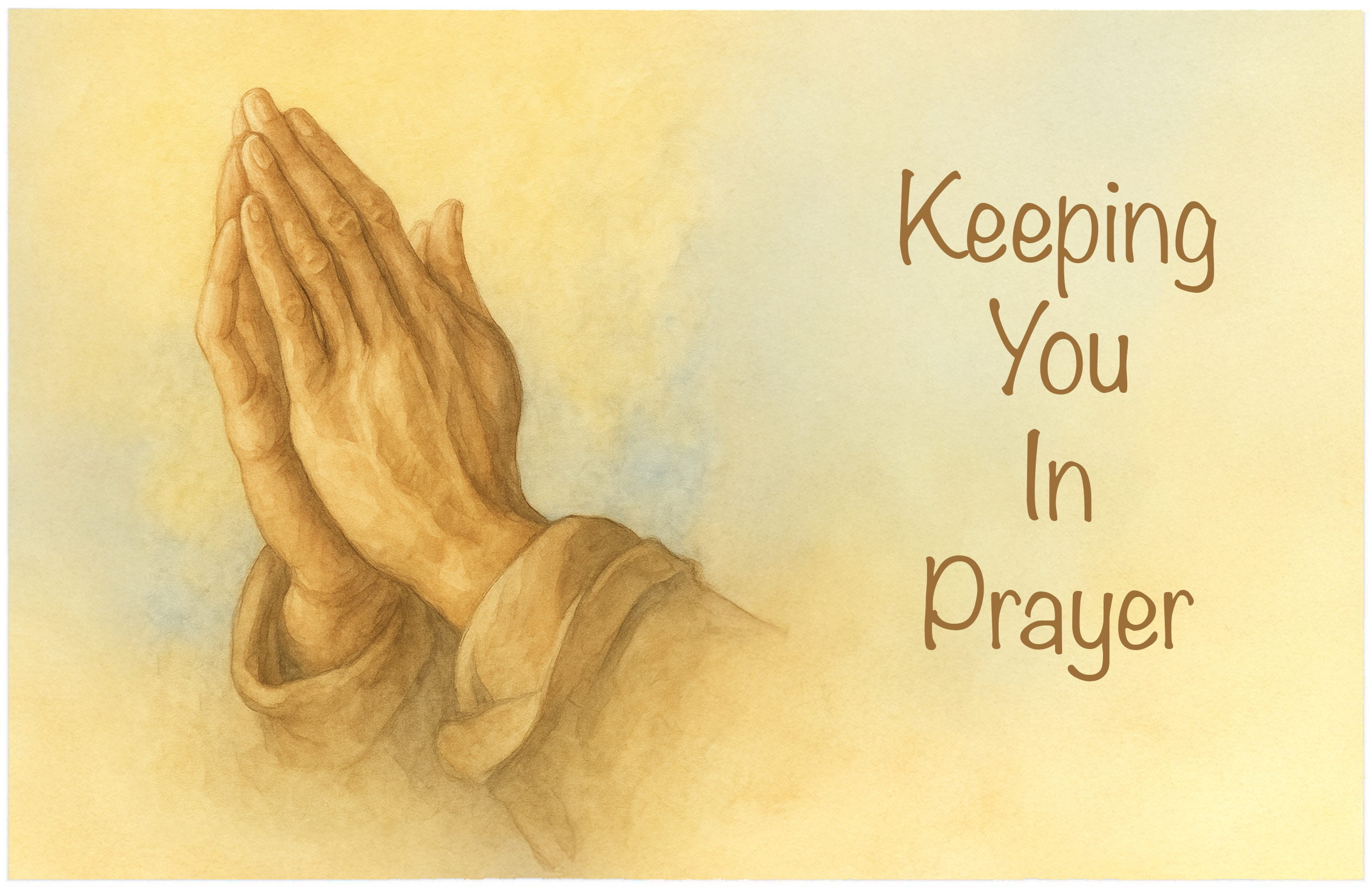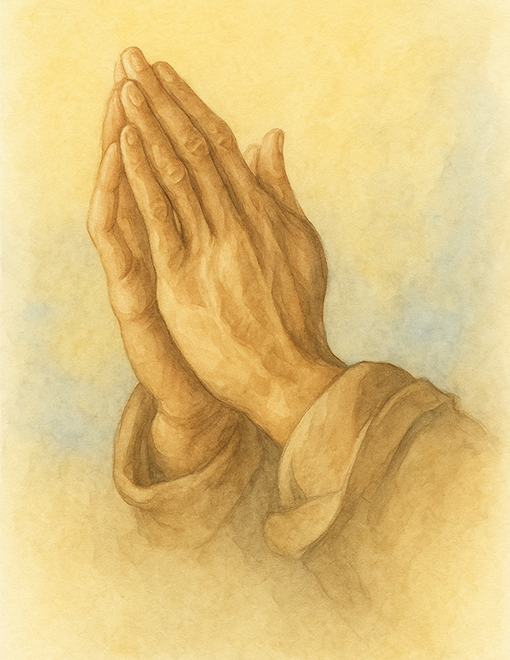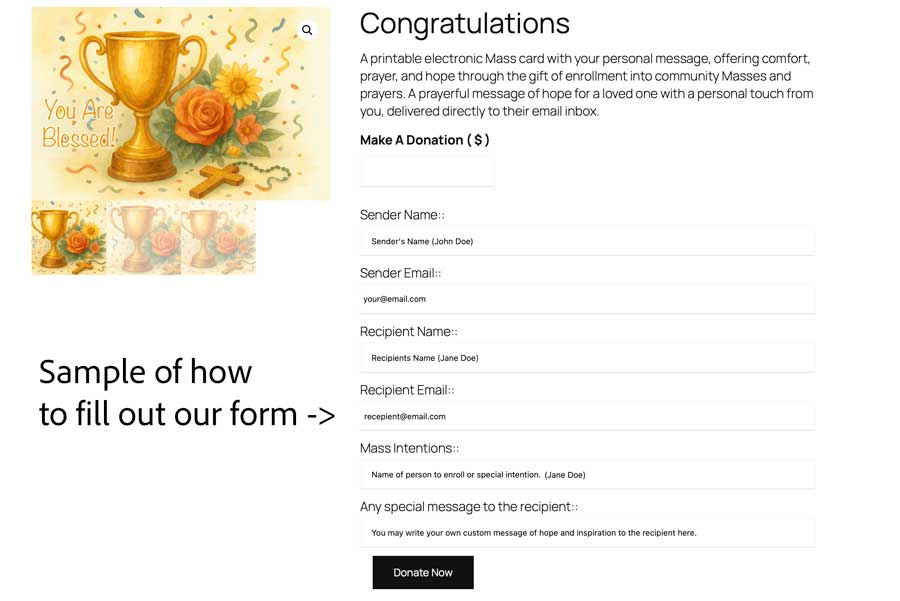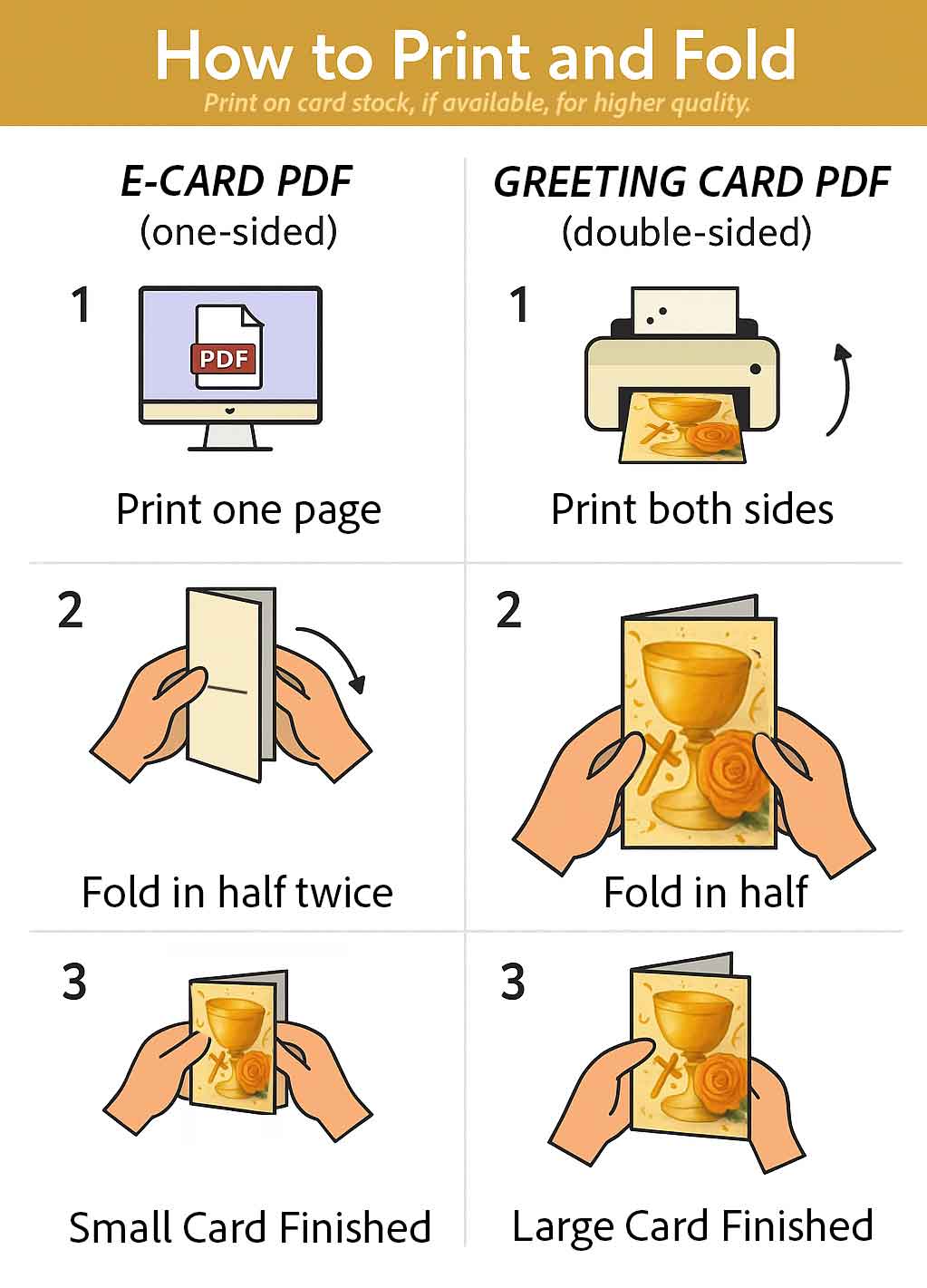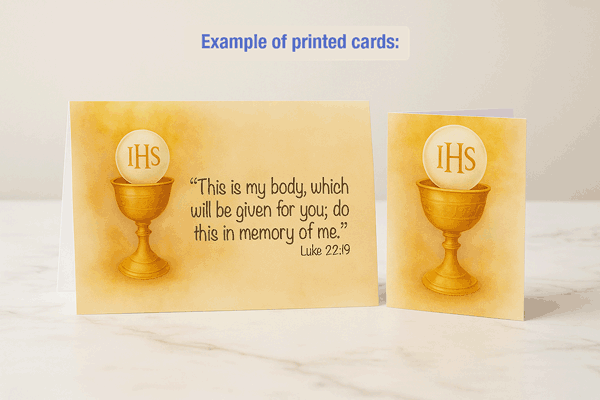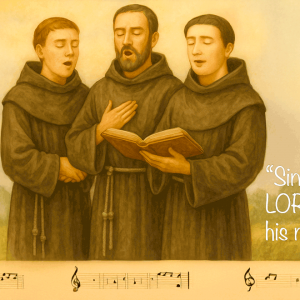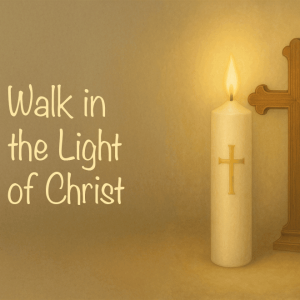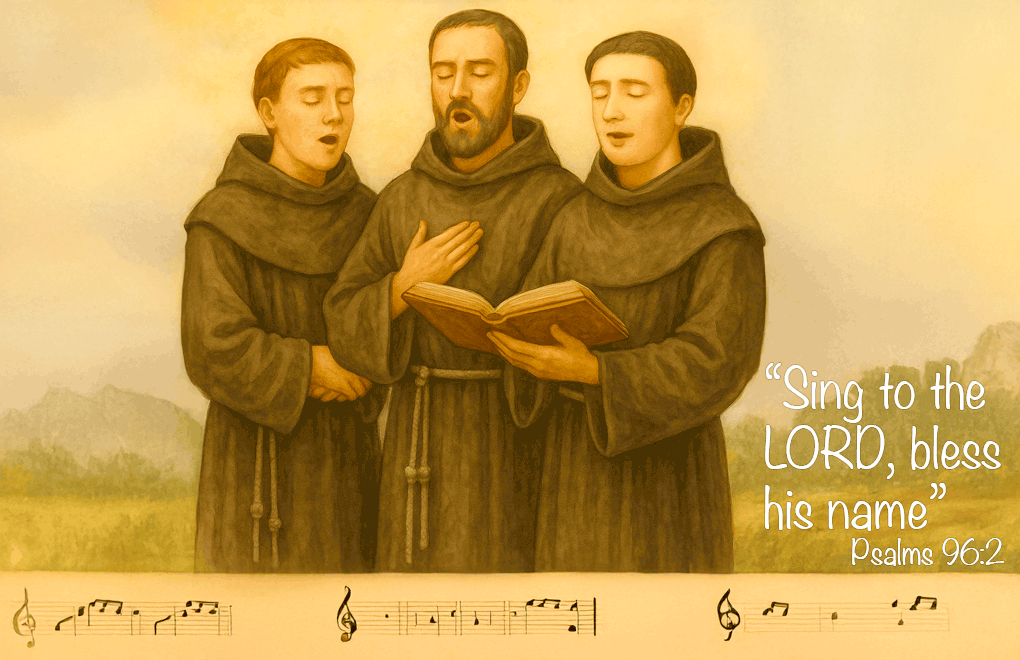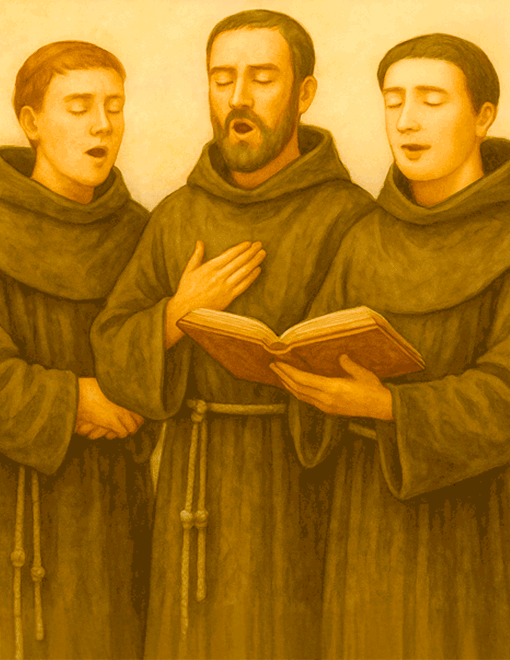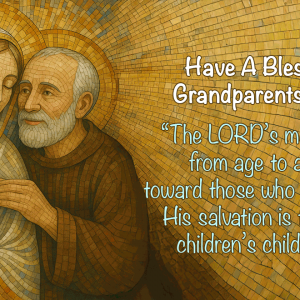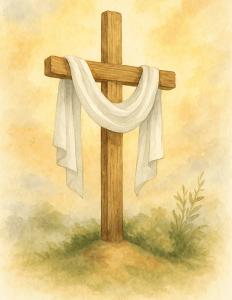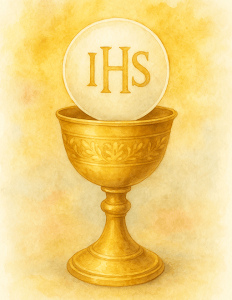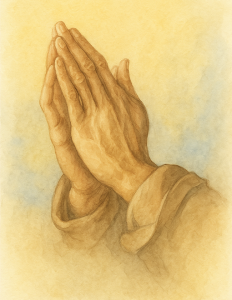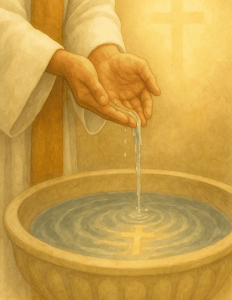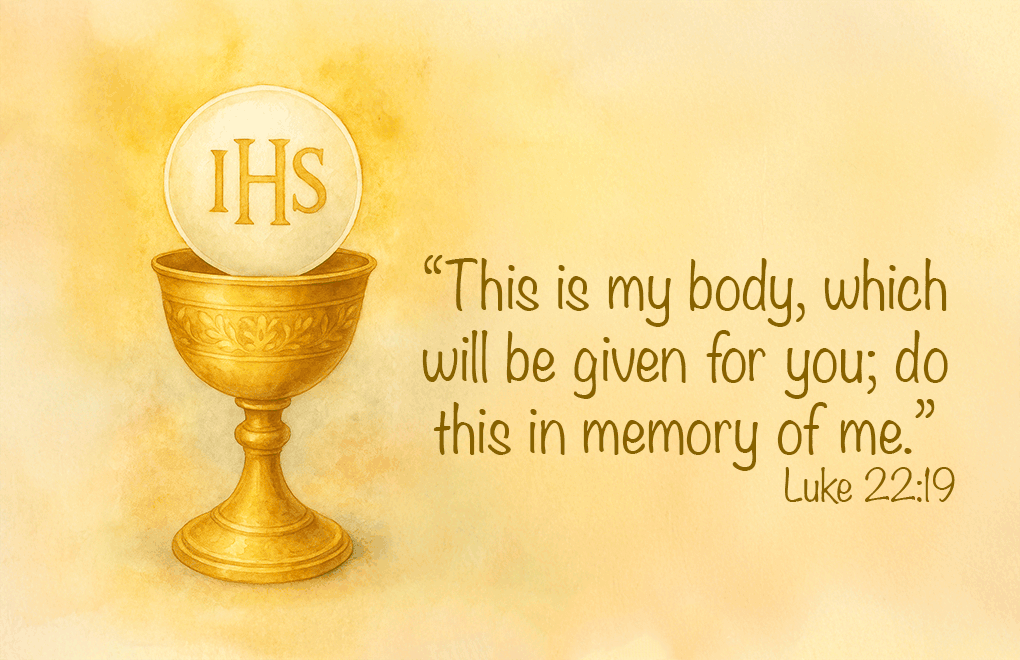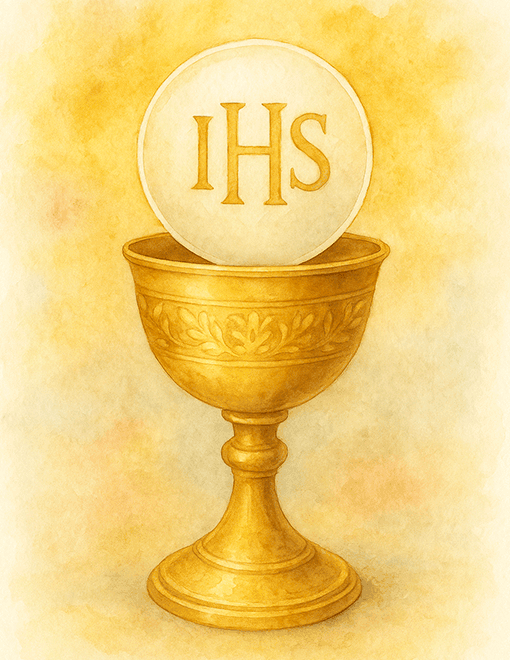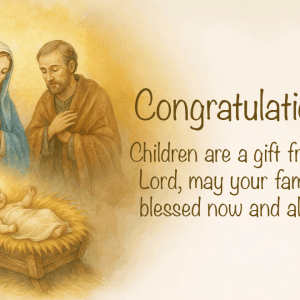Your cart is currently empty!
Category: General Catholic
-
Christian VS Catholic
Understanding the Words “Christian” and “Catholic”
The word Christian is one of the oldest names for the followers of Jesus. The Acts of the Apostles tells us that “it was in Antioch that the disciples were first called Christians” (Acts 11:26). To be Christian means to believe in Jesus Christ, to be baptized in His name, and to follow His teachings. It is a word that unites all who profess faith in the Son of God.
The word Catholic came soon after. It means “universal” in Greek. Early writers used it to describe the whole Church spread across nations, united in the same faith, sacraments, and leadership. By the second century, Saint Ignatius of Antioch spoke of “the Catholic Church,” meaning the complete and visible community of believers gathered around the bishops and in communion with the successor of Peter.
All Catholics are Christians, but not all Christians are Catholics. The Catholic Church is the original community founded by Christ and His apostles. It continues to profess the same faith, celebrate the same sacraments, and live under the same mission that Jesus gave to His disciples: “Go therefore and make disciples of all nations, baptizing them in the name of the Father and of the Son and of the Holy Spirit” (Matthew 28:19).
Over the centuries, other Christian communities emerged, each seeking to live the Gospel according to its own understanding of Scripture and tradition. The Catholic Church recognizes the faith and baptism shared with these brothers and sisters in Christ. The Second Vatican Council teaches that “many elements of sanctification and of truth are found outside the visible confines of the Catholic Church,” and that these elements “are gifts belonging to the Church of Christ” (Lumen Gentium, 8).
The Catholic Church sees herself as the fullness of the Christian faith, holding together Scripture, tradition, and the sacramental life as handed down from the apostles. Her unity is expressed in the creed we profess each Sunday: “I believe in one, holy, catholic, and apostolic Church.” The word catholic in that creed still means universal—a Church open to every people, language, and culture.
To be Catholic is to be part of this universal communion. It means belonging to a faith that has spanned centuries and continents, celebrating the same Eucharist that the early Christians celebrated, and remaining in communion with the successor of Peter, the Bishop of Rome.
To be Christian is to belong to Christ. To be Catholic is to live that belonging within the Church that He founded. Both words speak of identity and relationship. They remind us that faith is not lived in isolation but in communion—with God and with one another.
In a world that often divides, these words invite unity. The Christian name marks the beginning of faith. The Catholic name expresses its fullness. Together, they call every believer to follow Christ more closely, to seek holiness, and to bear witness to His love in the world.
General Donation
Your tax-deductible donation today will support our Catholic Mission Society and global outreach to the poor. Thank you for being generous to those in need. May God bless you for your kindness.
-
Church Songs
Songs of the Catholic Church
Music has always been part of the Church’s prayer. From the first gatherings of Christians to the great cathedrals of Europe, song has carried the voice of faith through the centuries. Each hymn, whether ancient or new, helps the faithful lift their hearts to God.
Gregorian Chant remains the foundation of Catholic sacred music. Its melodies, sung in unison and free rhythm, give life to the words of Scripture. The Kyrie eleison, Gloria in excelsis Deo, and Agnus Dei are familiar examples. These chants are sung not to entertain but to pray. The simplicity of the line draws the soul into stillness, allowing the Word of God to speak clearly.
Among the best-known Marian chants is the Salve Regina (“Hail, Holy Queen”). This hymn has been sung for nearly a thousand years in monasteries, processions, and the Rosary. It expresses trust in Mary’s intercession and her care for those who seek her help.
The Church also treasures the Eucharistic hymns of Saint Thomas Aquinas, written in the thirteenth century for the feast of Corpus Christi. Hymns such as Pange Lingua Gloriosi, Tantum Ergo Sacramentum, and Adoro Te Devote honor the real presence of Christ in the Eucharist. Their poetry and reverence continue to inspire prayer before the Blessed Sacrament.
In later centuries, new hymns enriched the life of the Church. O Salutaris Hostia praises Christ who opens heaven through His sacrifice. Holy God, We Praise Thy Name proclaims God’s majesty and is often sung at Benediction and feast days. Immaculate Mary celebrates devotion to Our Lady, echoing the faith of pilgrims at Lourdes and beyond.
The Ave Maria has become one of the most beloved prayers in song. Composers such as Schubert and Gounod gave musical form to the angel’s greeting to Mary. Wherever it is sung, the Ave Maria reminds the faithful of Mary’s presence in the story of salvation.
During Lent, the Church turns to hymns like Attende Domine (“Hear Us, O Lord”) and Stabat Mater (“At the Cross Her Station Keeping”). These songs invite reflection on repentance and the sorrow of the Blessed Mother at the foot of the Cross. At Easter, joyful hymns such as Regina Caeli Laetare (“Queen of Heaven, Rejoice”) and Jesus Christ Is Risen Today proclaim the victory of the Resurrection.
In more recent times, hymns in the English language have become part of Catholic memory and devotion. Here I Am, Lord, based on Isaiah 6, speaks of God’s call and the believer’s response. Be Not Afraid offers comfort from the words of Scripture: “Do not be afraid; I am with you.” These songs are often heard in parish liturgies and at moments when faith must overcome fear.
Catholic funerals, in particular, carry some of the most beloved modern hymns. On Eagle’s Wings, based on Psalm 91, assures the grieving that God’s love will lift and sustain them: “And He will raise you up on eagle’s wings, bear you on the breath of dawn.” Other favorites include Amazing Grace, How Great Thou Art, and I Am the Bread of Life. Each one expresses hope in eternal life and trust in God’s mercy.
The Church welcomes many musical forms, but all sacred music shares one purpose: to glorify God and sanctify the faithful. The Second Vatican Council reaffirmed that sacred music should “add delight to prayer, foster unity of minds, and give solemnity to the liturgy.” In this way, music becomes not performance but prayer.
From ancient monasteries to today’s parish pews, the songs of the Church have never ceased. Every chant, hymn, and psalm reminds the faithful that praise is part of the Christian life. Saint Augustine once said, “He who sings prays twice.” In song, the heart speaks what words alone cannot say.
The melodies may differ from one country to another, yet the purpose is the same—to lift the soul to God. Whether through Gregorian chant, Marian hymns, Eucharistic praise, or modern songs of hope, the voice of the Church continues to sing across time: a single hymn of faith, gratitude, and love.
General Donation
Your tax-deductible donation today will support our Catholic Mission Society and global outreach to the poor. Thank you for being generous to those in need. May God bless you for your kindness.
-
Morning Prayers
Start your day with God
Each morning, when the light returns and we open our eyes to a new day, the Church invites us to begin with prayer. Morning prayer is one of the most ancient practices of Christian life. It is the moment when we turn our first thoughts toward God and give Him the first fruits of our attention.
From the earliest centuries, Christians understood that prayer orders the heart. Saint Basil once wrote that we should “give thanks to God as soon as we are awake, before all else.” The rhythm of morning prayer shapes how we see the hours ahead. It reminds us that life is a gift and that every task, large or small, can become an act of love.
The psalmist says, “O Lord, in the morning you hear my voice; in the morning I plead my case to you, and watch” (Psalm 5:3). The first prayer of the day is not meant to be complicated. It is a turning of the soul toward the One who created the dawn. Even a brief moment of silence before the Lord has power to steady the heart.
Many Catholics begin the day with the Sign of the Cross and the Morning Offering:
O Jesus, through the Immaculate Heart of Mary,
I offer You my prayers, works, joys, and sufferings of this day
for all the intentions of Your Sacred Heart,
in union with the Holy Sacrifice of the Mass throughout the world,
for the salvation of souls, the reparation of sins,
and the reunion of all Christians.
I offer them for the intentions of our Holy Father, the Pope,
and for all that You desire, my Lord. Amen.This prayer expresses the heart of Catholic spirituality. It unites our daily life to the Eucharist being celebrated around the world. It reminds us that even ordinary work or quiet suffering can be offered as prayer. In that offering, we live the words of Saint Paul: “Whatever you do, in word or deed, do everything in the name of the Lord Jesus” (Colossians 3:17).
Another beautiful practice is to pray the Canticle of Zechariah (Luke 1:68–79), also known as the Benedictus. It is the prayer of John the Baptist’s father, spoken at the dawn of salvation history:
Blessed be the Lord, the God of Israel;
He has come to His people and set them free.
He has raised up for us a mighty savior,
born of the house of His servant David.The Benedictus praises God for His faithfulness. It reminds us that the light of Christ rises each morning to scatter the darkness of fear and sin. Praying it at sunrise places us in the story of salvation that continues to unfold each day.
Some also begin with the Prayer to the Holy Spirit, asking for guidance in every word and action:
Come, Holy Spirit, fill the hearts of your faithful,
and kindle in them the fire of your love.
Send forth your Spirit and they shall be created,
and You shall renew the face of the earth.This prayer, short and simple, invites the Spirit to dwell within us as we go about the day’s work. It prepares us to meet each person with patience and kindness.
In monasteries and convents, the Church’s official morning prayer is called Lauds, part of the Liturgy of the Hours. It begins with the words, “Lord, open my lips, and my mouth will proclaim your praise.” Even if we cannot pray the full Office, this line can become a daily habit. It acknowledges that our speech, our thoughts, and our choices belong to God.
Morning prayer is not about reciting many words. It is about beginning the day in relationship with the Lord. Whether you pray a traditional formula, read a psalm, or simply speak from your heart, what matters is faithfulness. Each morning offers a new chance to consecrate the day to God’s glory.
Pope Francis often reminds the faithful to begin each day with gratitude. In one of his homilies he said, “The first step toward holiness is to live each day by saying ‘Thank you, Lord.’” Gratitude turns duty into joy. It helps us see grace in the ordinary.
As the hours of the day unfold, morning prayer remains an anchor. It carries us through decisions, conversations, and work. When we begin with prayer, our hearts remember throughout the day that we walk with Christ.
The Church’s tradition offers many prayers, yet the most powerful words are sometimes the simplest:
Good morning, Lord. I thank You for this new day.
Be with me in all I do. Bless my family, my work, and my thoughts.
May everything I say and do give glory to Your name. Amen.When we rise each day and lift our hearts to God, we join millions of believers who do the same. The sun rises over monasteries, cities, and villages, and the Church prays with one voice. Morning prayer joins heaven and earth in praise. It begins the day with faith, and faith makes every moment holy.
Keeping You In Prayer
We will send a printable card to the recipient’s email with instructions how to print the card at home. Each card has the image to the left with a personal message from you (optional below). Our electronic enrollment cards offer comfort, prayer, and hope through the gift of a spiritual enrollment into our mission society which includes remembering your intentions in community Masses and prayers through our global partners and beneficiaries.
Deliver a prayerful message of hope to a loved one today.
Description
Send a meaningful Mass Card Enrollment directly to a loved one. By enrolling them, you unite their name with the prayers and community Masses offered by our partner religious organizations around the world. This special gift supports Catholic mission work around the world. If you do not know your loved one’s email we suggest you send the card to yourself and deliver it by mail or in person.
Your gift supports the Catholic Church’s international ministries and will be used to sustain clergy and provide vital aid such as: food, clean water, health care, and education for those most in need. Our mission society partners with communities like the Franciscans, Lasallians, Jesuits, and other Catholic organizations world-wide. We don’t ask you for a specific donation; we ask only that you give the most generous amount in your heart today. Every offering is a blessing to those in need who seek Christ’s mercy. May God bless you for supporting our global missions.
-
Gregorian Chant
Gregorian chant has long been known as the song of the Church. When it is heard, a quiet reverence fills the air. The sound is pure and prayerful. It does not rely on instruments or rhythm to hold attention. It simply carries sacred words on a single melodic line. Each note rises and falls gently, lifting your heart toward God. This is why the Church has long said that chant belongs in a special way to her liturgy.
From the earliest centuries, Christians sang the Psalms, Scripture, and prayers in ways that reflected the beauty and holiness of what they believed. The faithful learned melodies that gave shape to their prayer, and through song, they carried the Word of God into daily life.
By the sixth century, Pope Gregory the Great gave new order to the musical tradition of chants. He gathered the sacred chants of Rome, organized them and ensured that they could be preserved and taught. His work was so influential that this body of sacred song came to bear his name: Gregorian chant.
For centuries, monks in monasteries rose before dawn to sing these ancient melodies. Cathedrals taught them to choirs of boys and clerics. The Church has learned to pray through Gregorian chant.
Through time, wars, reformations, and changing musical fashions, Gregorian chant endured. It was preserved especially in monasteries, where communities such as the Benedictine monks of Solesmes in France took up the task of restoration during the nineteenth century. They studied old manuscripts, repaired damaged scores, and worked to recover the original rhythm and purity of the melodies. Their dedication gave the Church the Liber Usualis, a monumental book containing the chants for the Mass and Divine Office. Because of their careful work, chant once again became known throughout the world as the standard of sacred music.
At the Second Vatican Council, the bishops of the world reaffirmed the importance of chant in the life of the Church. The document Sacrosanctum Concilium states that “the Church acknowledges Gregorian chant as specially suited to the Roman liturgy; therefore, other things being equal, it should be given pride of place in liturgical services.” This teaching reflects the timeless character of chant. Its beauty is not a fad. It remains close to Scripture, humble in form, and universal in spirit.
Gregorian chant is sung in unison, without harmony or accompaniment. It is not meant to entertain or to be performance in nature. It invites prayerful contemplation. The melody follows the natural rhythm of the words, allowing the listener to focus on their meaning. The modes and intervals are ancient, shaped uniquely for contemplation. When even a small group choir begins to sing Kyrie eleison, the sound unites the whole Church in worship. The melody opens a path for the soul to listen more deeply.
Singing chant also connects us to the those who came before us. When we hear it in a parish today, we share something with the monks who sang it in stone chapels a thousand years ago. We join the voices of the faithful who heard it under the vaulted ceilings of medieval cathedrals. Chant bridges centuries. It unites believers in every age with the same faith and the same praise.
In our own time, the Church continues to cherish this tradition. Pope Francis spoke often of the importance of sacred music that draws people toward prayer. The Vatican’s Pontifical Institute of Sacred Music continues to train musicians and clergy in chant and polyphony, ensuring that the sound of the Church’s prayer remains faithful to its roots. Recently, the Vatican launched the initiative “Let’s Sing with the Pope”, inviting Catholics worldwide to learn the simple beauty of Gregorian chant alongside the Holy Father, Pope Leo XIV. This project helps the world rediscover a form of music that nourishes faith through reverence and peace.
Gregorian chant remains what it has always been: prayer set to melody. It does not belong to one culture or century. When the faithful listen or sing, they are united with generations who found in these tones a way to enter into the divine mystery of God. Its simplicity is sacred.
As the Church renews its attention to chant in our own day, the Spirit breathes through an ancient gift once more. In a world filled with noise, Gregorian chant teaches us again how to listen, how to pray, and how to find stillness in the presence of God.
Gregorian Mass Card
We will send a printable card to the recipient’s email with instructions how to print the card at home. Each card has the image to the left with a personal message from you (optional below). Our electronic enrollment cards offer comfort, prayer, and hope through the gift of a spiritual enrollment into our mission society which includes remembering your intentions in community Masses and prayers through our global partners and beneficiaries.
Deliver a prayerful message of hope to a loved one today.
Description
Pope Gregory the Great was known as an advocate for the poor and promoter of missions, he also is credited with popularizing Gregorian Chant.
Send a meaningful Mass Card Enrollment directly to a loved one. By enrolling them, you unite their name with the prayers and community Masses offered by our partner religious organizations around the world. This special gift supports Catholic mission work around the world. If you do not know your loved one’s email we suggest you send the card to yourself and deliver it by mail or in person.
Your gift supports the Catholic Church’s international ministries and will be used to sustain clergy and provide vital aid such as: food, clean water, health care, and education for those most in need. Our mission society partners with communities like the Franciscans, Lasallians, Jesuits, and other Catholic organizations world-wide. We don’t ask you for a specific donation; we ask only that you give the most generous amount in your heart today. Every offering is a blessing to those in need who seek Christ’s mercy. May God bless you for supporting our global missions.
-
Catholic Holy Days of Obligation
The Church invites her children to live according to the rhythm of grace marked by the liturgical year. Each Sunday is a holy day in itself, a day set apart for worship and rest. Alongside these Sundays, the Church names specific feast days as Holy Days of Obligation. On these days, the faithful are called to gather for the Eucharist and to pause from ordinary routines. We give time back to God, recognizing His presence in our lives and allowing His grace to renew us.
These special days highlight central truths of the faith. They recall the Incarnation, the life and glory of Christ, the holiness of Mary, and the communion of the saints. Each feast teaches something essential about salvation and what it means to belong to God. To keep them holy is to remember who we are as His people and what we are called to become.
A Holy Day of Obligation is a feast day on which Catholics are asked to attend Mass. The Church gives this instruction not as a rule but as a gift. The Eucharist is the center of Christian life. By gathering on these days, we remember that faith is not private but shared. We stand together before God in gratitude for the mysteries of our salvation.
In the United States, the Holy Days of Obligation are:
- January 1: Solemnity of Mary, Mother of God – The year begins under the protection of Mary, who is honored as the Mother of God.
- Thursday of the Sixth Week of Easter: Ascension of the Lord – In many dioceses, this feast is celebrated on the following Sunday. We remember Christ’s return to the Father and our call to eternal life.
- August 15: Assumption of the Blessed Virgin Mary – Mary is taken body and soul into heaven, showing us the destiny God desires for all who believe.
- November 1: All Saints’ Day – We give thanks for the holy men and women who now live in God’s presence and intercede for the Church.
- December 8: Immaculate Conception of the Blessed Virgin Mary – This is the patronal feast of the United States. It celebrates Mary’s preservation from original sin by God’s grace.
- December 25: The Nativity of Our Lord Jesus Christ – The birth of our Savior, the Word made flesh, who came to dwell among us.
When January 1, August 15, or November 1 fall on a Saturday or Monday, the bishops of the United States lift the obligation to attend Mass that year. The feasts of the Immaculate Conception and Christmas always remain obligatory, as they are central to our faith.
To keep these days holy, we begin by participating in the Eucharist. This is the heart of every feast. The Church also encourages quiet prayer, reflection on the mystery being celebrated, and acts of charity. When we pray and serve, these days become moments of grace for the world around us.
Each Holy Day of Obligation reminds us that worship and service belong together. At the altar, we meet Christ who gives Himself for us. In daily life, we meet Him again in the poor, the sick, and the forgotten. Acts of charity allow the grace of the Eucharist to bear fruit in love.
At CatholicMasses.org, almsgiving supports Catholic missions that carry this love to those in need. If you are homebound or unable to attend Mass in person, you are invited to join a Virtual Mass online. Offerings made here support schools run by religious sisters, food programs for children, health care for the sick, and the preaching of the Gospel across the world. In this way, every act of participation joins spiritual devotion with real works of mercy, uniting the faithful everywhere in one Body of Christ.
-
Language During Mass
Bible Differences Between Countries and Cultures
Many Catholics have noticed that Mass in Canada sounds slightly different from Mass in the United States. The prayers and readings follow the same rhythm, yet familiar verses can sound a little different. A line from the Psalms may use one word in Canada and another in the United States. These differences often raise a question: Why does the same Mass sound different across borders?
The answer lies in translation. The Liturgy of the Word depends on an approved translation of Scripture, called the lectionary. Each bishops’ conference is responsible for preparing and approving this translation for use in its territory. In English-speaking countries, this means that the Canadian Conference of Catholic Bishops (CCCB) and the United States Conference of Catholic Bishops (USCCB) each oversee their own version, with final approval from the Holy See.
Canada’s lectionary is based on the New Revised Standard Version, Catholic Edition (NRSV-CE). The United States uses the New American Bible, including its updated Revised Edition (NABRE). Both versions were developed with deep respect for Scripture and approved through the same process. While the language may sound slightly different, both proclaim the same Word of God.
The Church has always embraced different languages and expressions of faith. From the first Pentecost, when the Holy Spirit enabled people to hear the Gospel in their own tongue, the Church has known that one truth can be spoken in many voices. The early Christians prayed in Greek, Latin, and other local languages. Today, the Mass continues to reflect that diversity.
English itself varies from place to place. The English spoken in Toronto carries a different rhythm than the English of Chicago or New York. The same happens in Scripture. One translation might read, “The Lord said to his servant,” while another says, “The Lord spoke to his servant.” A psalm verse might say, “Happy are those who trust in the Lord,” while another reads, “Blessed are they who put their trust in the Lord.” The phrasing changes, but the meaning remains the same.
Consider the words of Isaiah. In the American lectionary we hear, “So shall my word be that goes forth from my mouth; it shall not return to me void.” In the Canadian lectionary the same passage reads, “So shall my word be that goes out from my mouth; it shall not return to me empty.” The words “void” and “empty” differ slightly in sound, yet both proclaim the same truth: God’s Word fulfills its purpose and never fails.
The Evolution of the U.S. Lectionary
In the United States, the process of refining the biblical text has unfolded slowly and carefully. The New American Bible (NAB) was first published in 1970. It reflected the Church’s desire, after the Second Vatican Council, to make Scripture accessible in the language people spoke every day. Over time, scholars discovered new ancient manuscripts and learned more about the languages of the Bible. As the English language continued to evolve, the Church revised the text so that it could be understood clearly when proclaimed aloud.
In 2011, the New American Bible, Revised Edition (NABRE) was released. It offered more precise translations and closer attention to the biblical sources. This effort was part of a broader renewal that also touched the language of the Mass itself. That same year, a new English translation of the Roman Missal was introduced.
One example appears in the words before Communion. For many years Catholics said, “Lord, I am not worthy to receive you, but only say the word and I shall be healed.” The revised text now says, “Lord, I am not worthy that you should enter under my roof, but only say the word and my soul shall be healed.” The new wording restores a vivid image from the Gospel (Matthew 8:8), where the centurion humbly tells Jesus that his home is unworthy of His presence. The change connects the prayer at Mass directly to Scripture and deepens its meaning.
The work of translating Scripture is deliberate. The Church values accuracy more than speed. Every translation passes through study, review, and approval by the Vatican’s Dicastery for Divine Worship. This process ensures that the faith expressed in different regions remains one in truth and meaning.
In late 2024, the U.S. bishops approved a new lectionary that harmonizes the readings at Mass with the NABRE. This updated version will help American Catholics hear the Scriptures in clear and faithful language suited for public proclamation.
Unity Through Diversity
Each national bishops’ conference carries the responsibility of preparing a translation that serves its people well. The bishops understand how language and culture shape how Scripture is heard. Rome’s approval confirms that every translation remains faithful to the same apostolic teaching.
An American visiting Canada may notice a few differences in phrasing, yet both countries proclaim the same Word under the same Church authority. Across the world, the Eucharist is celebrated in many languages. The readings in Kenya, Ireland, or the Philippines sound different, yet the message is one.
The Church’s unity does not depend on identical words. It rests on communion in faith, sacraments, and truth. From the early Church to today, Catholics have understood that diversity in language enriches the universal mission of the Gospel. The same Christ is proclaimed, the same altar is shared, and the same faith is professed.
The Church speaks in many tongues but with one heart. Each translation of Scripture reflects the beauty of God’s Word through a different voice. The meaning does not change; it shines in many colors like light through stained glass. Whether the readings are heard in English, French, or Swahili, the Word remains the same: living, faithful, and full of grace.
Bread of Life
We will send a printable card to the recipient’s email with instructions how to print the card at home. Each card has the image to the left with a personal message from you (optional below). Our electronic enrollment cards offer comfort, prayer, and hope through the gift of a spiritual enrollment into our mission society which includes remembering your intentions in community Masses and prayers through our global partners and beneficiaries.
Deliver a prayerful message of hope to a loved one today.
Description
Send a meaningful Mass Card Enrollment directly to a loved one. By enrolling them, you unite their name with the prayers and community Masses offered by our partner religious organizations around the world. This special gift supports Catholic mission work around the world. If you do not know your loved one’s email we suggest you send the card to yourself and deliver it by mail or in person.
Your gift supports the Catholic Church’s international ministries and will be used to sustain clergy and provide vital aid such as: food, clean water, health care, and education for those most in need. Our mission society partners with communities like the Franciscans, Lasallians, Jesuits, and other Catholic organizations world-wide. We don’t ask you for a specific donation; we ask only that you give the most generous amount in your heart today. Every offering is a blessing to those in need who seek Christ’s mercy. May God bless you for supporting our global missions.
-
Attendance at Mass
From the earliest days of the Church, Christians gathered in community to celebrate the Resurrection of the Lord. We call this celebration the Eucharist, or the Mass. “The Sunday celebration of the Lord’s Day and his Eucharist is at the heart of the Church’s life” (CCC 2177). It is the central act of our faith, where we give thanks to God for the gift of salvation. At Mass, we listen to the Word of God, we lift up our prayers, and we receive Jesus Christ in the Blessed Sacrament. The Church teaches that this sacred celebration is the heart of Christian life and that it unites us with Christ and with one another.
Catholics are asked to attend Mass every Sunday and on holy days of obligation. When we gather as a community of believers, we remember who we are and why we are gathered together. God calls us into communion, and the Mass strengthens that communion.
The Church teaches that the Mass is a re-presentation (that is, a making-present again) of the sacrifice of Christ on the Cross. Jesus offered Himself once for all on Calvary (Hebrews 10:10). That sacrifice does not repeat, and it does not need to. But in the Eucharist, the same sacrifice is made present to us sacramentally. Time does not divide it. God allows the one saving act of Christ to reach every generation through the liturgy, and in particular receiving communion.
The Church also teaches with mercy. She knows there are times when a person cannot attend Mass. Illness, frailty, or serious family duties can prevent someone from attending Mass in person. In those moments, it is right to remain at home and to pray. This is not a failure. It is an act of humility and care for others.
The Church encourages those who stay home to read the Scripture readings of the day, to pray quietly, or to unite their hearts to the Eucharist being offered throughout the world. Many people now find comfort in participating through televised or online Masses. During the pandemic, this practice helped many of the faithful remain close to the Church. This website in particular helped bring Mass to thousands of faithful during that time. Watching Mass online cannot fully replace being physically present, yet it can strengthen faith and bring peace to those who cannot attend. The readings, homily, and prayers deliver God’s Word in every home. Those who join online way can make a spiritual communion, asking Jesus to enter their hearts with the same love He gives in the Eucharist.
The Church is one family. When we gather for Mass, we pray for those who cannot be with us. Those who are sick or homebound can offer their daily sufferings, their hopes, and their prayers for others. Through this exchange of love, the whole Body of Christ remains united.
The grace we receive in the Eucharist should overflow into our daily lives. Every act of kindness, every prayer for someone in need, every small gift of charity carries that grace into the world. Through CatholicMasses.org, the faithful can extend the spirit of the Mass by supporting missions that feed the hungry, educate children, and care for the poor. In this way, even those who watch from home take part in the living mission of the Church.
Saint Thomas Aquinas taught that charity is the crown of all virtues. It gives meaning to everything we do. When we love with sincerity, when we pray with faith, and when we serve others, we live the mystery of the Eucharist. Whether we are in the church pews or in our homes, Christ calls us into the same communion of love.
General Donation
Your tax-deductible donation today will support our Catholic Mission Society and global outreach to the poor. Thank you for being generous to those in need. May God bless you for your kindness.
